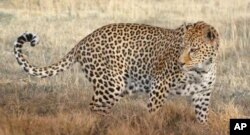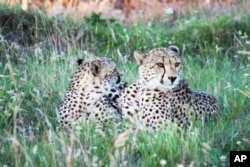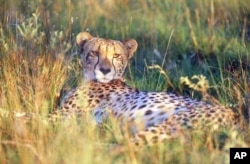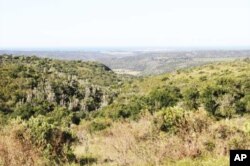This is Part 2 of a 5-part series South Africa: Reviving Endangered Wildlife
Go to Part: 1 / 2 / 3 / 4 / 5
Conservationists in an ecologically diverse part of South Africa have embarked on an ambitious project to reestablish a population of one of Africa’s most mysterious creatures
Since the early 1800s, farmers in the so-called “Albany Hotspot” – a species-rich strip of land between the Keiskamma and Sundays rivers in the country’s Eastern Cape province - have hunted the African leopard to the point where relatively few survive.
“With this part of the Eastern Cape traditionally being a stock farming area, over the generations leopards have killed many stock animals. This didn’t exactly endear this animal to the farmers, and they started to target leopards,” explained environmentalist and game reserve owner Dale Howarth.
“The indigenous leopards were hunted virtually to extinction. The ones that remained became totally nocturnal and petrified of human beings, and stayed in such dense riverine forest that you’d never view them.”
‘Secrecy’ of leopards allows them to survive
The leopard is by nature shy and elusive with an “unrivaled ability to climb trees and hide,” but being hunted by humans has made it even more difficult to track in an effort to establish its numbers, said another game park manager in the district, Alan Weyer.
But he and other Eastern Cape conservationists have seen enough leopard spoor, droppings and the carcasses of animals killed by the powerful carnivores to convince them that the cats are still prevalent in the region, although in much fewer numbers than in the past.
“Leopards in the Eastern Cape were the one major predator that wasn’t completely shot out over the years. That’s because they’re so secretive and you don’t see them. They’ve survived very well here (compared to other game animals),” said Weyer.
Several game parks in the region now have research projects that aim to establish, and then boost, leopard numbers. “We’ve got remote (infrared) cameras that are triggered all over the (Kariega) reserve. We’re putting them in places where we think the leopards might be moving,” said Weyer.
Howarth said his game reserve, Pumba, had “established a relationship” with state nature conservation authorities in other parts of the province “where leopards are still prevalent and are still competing with stock farmers.”
The government rangers inform Howarth when ranchers have been issued special state permits to destroy “problem” leopards that have been killing livestock.
“We’ve been able to come to an arrangement where we will go in and capture the problem leopard and pay (the farmer) for it. Via that (process) we’ve been able to acquire five leopards which we’ve brought into a rehabilitation and breeding program,” he told VOA.
Technology to track the cats
Soon, said Howarth, two of the leopards, females fitted with GPS collars, would be released onto his reserve. “A high electrified fence is no barrier to a leopard. It simply jumps the fence.
But with the GPS, we’ll be able to track them exactly where they move,” he explained, adding, “We have arrangements with neighboring farmers that should (the leopards) get out, I’ll be able to notify them within minutes because I’ll have my Google (satellite) map; I’ll know exactly where they are. They won’t destroy the animal; they’ll allow me to come and recapture it and bring it back in. At the same time, if (our leopards kill) any of their stock (animals), we will pay for that stock.”
Howarth’s hoping that the two female leopards establish territories within the park. As soon as that happened, he said, two males would be released to breed with the females.
“It’ll only be the original few leopards that we’ll collar with GPS technology; the progeny will be free ranging,” Howarth emphasized. “So then they can start establishing their own territories in neighboring reserves and neighboring areas, bringing a decent population of leopard back to the Eastern Cape.”
Weyer commented, “Having leopard back here in numbers just adds to this area’s amazing natural heritage.”
According to scientists, the “Albany Hotspot” is the third most species-diverse region in the world, after the Amazon Jungle in South America and the Cape Floral Kingdom in South Africa’s Western Cape province.
Cheetahs defy the textbooks
At Kwandwe Game Reserve, also in the “Hotspot,” another big cat species has been restocked. “The last recorded population of cheetah in our area was in 1888, and it was fantastic to see those animals back on the landscape again. It was an incredibly exciting time,” said Angus Sholto-Douglas, the park’s director.
He added that it had been “fascinating” to witness the cheetah “bucking the understanding” that he and other conservationists had of them. “We had this idea that they would live out on the open plains and feed on springbuck and do all the things that the textbooks told them to, and essentially they did just the opposite,” said Sholto-Douglas.
He said, for example, that the reserve’s cheetahs had not limited their diets to springbuck and other small antelope. “We’ve had an adult male cheetah kill an adult female eland. That’s an animal of six, seven, eight hundred pounds,” he said. The eland is Africa’s largest antelope. Adult male cheetahs seldom weigh more than 140 pounds.
Also, he said, the cheetahs were hunting “very successfully” in Kwandwe’s indigenous thickets. According to experts, cheetahs don’t like to frequent such vegetation.
Cheetahs vs. Lions
Before the restocking of cheetah at Kwandwe, experts warned the park’s owners that the animals would “clash” with the reserve’s resident lions. The biggest of big cats is traditionally the cheetah’s main enemy and competitor for food.
But Sholto-Douglas said the cheetahs had “demonstrated an incredible adaptability” to avoid lions by hiding in succulent thickets, in the absence of the long grass considered to be their natural shelter from harm.
Kwandwe’s cheetah project has been so successful that it’s now selling the cats to other Eastern Cape game reserves, allowing them to reestablish populations of the world’s fastest land animal.
International conservationists said the Eastern Cape reserves’ efforts to return leopards and cheetahs to the land would benefit not just Africa, but the world.










![Cheetahs traditionally chase down and kill springbuck like these, but in the ‘Albany Hotspot’ they’re even hunting larger antelope species [PHOTO CREDIT: Bucklands Game Reserve]](https://gdb.voanews.com/ED6346EC-B1F0-4A19-8BE3-3B4D482C8B5D_w250_r0_s.jpg)


